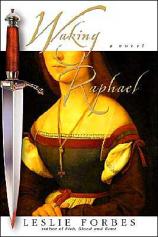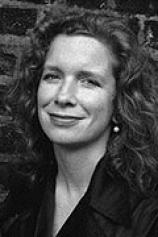Interview: July 23, 2004
July 23, 2004
Carol Fitzgerald, Roberta O'Hara and Wiley Saichek recently spoke with Leslie Forbes about her latest novel, WAKING RAPHAEL, which focuses on the mystery surrounding "La Muta," one of Raphael's masterpieces. In this interview Forbes discusses the importance of art in history as a way to show the truth of past events, especially from the point of view of the defeated. She also explains her decision to write fiction and provides readers with a preview of her upcoming books, THE AMPUTATIONS and THE MAN WHO LOVED HIS WIFE.
BRC: What was the inspiration to write about Raphael and specifically La Muta?
LF: I was impressed by how Raphael, who lived in a time even more cynical, dangerous, and corrupt than our own, managed to keep his faith in humanity. Was it Italian food and wine that kept him going --- or the women he enjoyed so much?
With "La Muta" it was the mystery implied by that title, which in Italian can mean either the "mute woman" or simply the "silent woman" --- suggesting that she could speak up if she wished to (and I've known a lot of people about whom you could say the same)! I began to wonder: what is the best response in the face of literally "unspeakable" crimes?
BRC: Have you studied art? Do you have a favorite painter or a favorite work?
LF: Yes, I did a degree in graphic design and film studies first in Canada and then another year at the Royal College of Art in London, England. Favourite modern artists would be Joseph Cornell and Robert Rauschenberg; favourite older painters probably Matisse and Piero della Francesca.
BRC: Your last two books were set in India. What made you decide to set a book in Europe?
LF: A restorative visit to Urbino in 2001, at a time when all the news in the world seemed bad… And a BBC radio documentary I was making then about a former mafia judge, which made me aware that while I knew a lot about Italian food, art and renaissance politics, I knew very little about modern Italian politics.
BRC: You clearly have a deep understanding of Italy and Italian culture. How much time have you spent there?
LF: I lived in Tuscany for six months in 1984-85 while researching and illustrating my food-travel diary, A TABLE IN TUSCANY [Penguin], and again in the early 1990s while writing and illustrating my food-travel adventures, REMARKABLE FEASTS [Bloomsbury]. And as a food and wine writer for many years, I often spent weeks traveling around Italy. Since 1992, I have also attended a bi-annual international scientific conference in Sicily.
BRC: How much of WAKING RAPHAEL is based on actual history?
LF: Most of it, although the original "mute woman" on whom I based the living mute in my novel actually lived in a remote village in Tuscany, not near Urbino. The names have been changed to protect the guilty, as well as the innocent!
BRC: What did you find most surprising and/or interesting during your research for WAKING RAPHAEL?
LF: Having decided to protect the identity of the living mute by transferring her story to Urbino, I discovered completely by surprise that one of the few masterpieces left behind by Raphael in his home town was the portrait "La Muta," which completely tied into my theme. Also the discovery that, during WWII, Urbino's best paintings were smuggled out of the museums and into the countryside to protect them from the German occupation.
BRC: Food and food descriptions are so much a part of this book. From your writing you sound like a true gourmand. Do you enjoy cooking or do you prefer to just be a guest at the table?
LF: I love cooking --- but only for people who like to eat! We're always having people round to dinner (and my partner, Andrew, isn't a bad cook either). But I'm equally happy to eat at other friends' tables --- even simple scrambled eggs and toast, as long as there's a glass of wine with it.
BRC: At one point Charlotte sees this in her notes: "If a woman had to stop talking to save her life, what would it take to start her talking again?" This statement could seemingly stand as a thesis statement for the novel. What inspired this idea, and then, this plot?
LF: Invited to the Edinburgh Book Festival in 2000 to talk about my second book, FISH, BLOOD & BONE, I was asked at an event organised by International PEN (of which I'm a member) to read aloud a poem by an assassinated Algerian writer: "Silence is death, If you are silent you are dead, And if you speak you are dead, So speak and die." It reminded me of the mute woman I'd met years ago in Tuscany, and led to me questioning my own silence about current politics --- and to examine the cover-ups that have taken place internationally over the last fifty years.
BRC: Charlotte also wrote, "A person with no voice has no more history than a stone does or a dog." Explain this idea.
LF: It came from my work as a volunteer writing "mentor" with refugees who have been tortured for their political beliefs, torture that effectively takes away their "voices" and prevents them from giving their side of the story --- and hence erases them from history. History is told by the victors, seldom by the victims or the vanquished. Fiction, poetry, painting let people tell their story in a way that's more difficult to deny.
BRC: Was there a reason that you selected "Camptown Races" as the song that was sung by the soldiers?
LF: Its connections with the American south, and the song's senseless chorus (doo-dah, doo-dah), which contrasts with the senseless violence that takes place in my novel while the chorus is sung.
BRC: You are trained as a journalist. How do you think this affects your novel writing?
LF: It gives me lots of material, for a start! It also makes me interested in how the past continues to influence the present.
BRC: What made you decide to move from journalism to fiction? Do you still write nonfiction?
LF: Because of editorial policies and the risk of lawsuits, it is increasingly difficult to tell the truth through journalism. By telling the "lies" that are fiction, I get a chance to probe the truth! However, I'm passionate about radio and do still make documentaries for BBC radio, as well as writing about the arts.
BRC: What authors do you enjoy reading? Which authors inspired you and/or continue to inspire you?
LF: Apart from popular science (to which I have a mild addiction!), I particularly love good storytellers (in no particular order): Ian McEwan, Jim Crace, Margaret Atwood, Anne Tyler, Cormac McCarthy, Peter Carey, Michael Ondaatje, Elmore Leonard, James Ellroy. Inspiration continues to come from them, as well as from my old favourites: Graham Greene, Iris Murdoch, Primo Levi and John le Carre --- and my love of India leads me to re-read on a regular basis the works of Rumer Godden, Paul Taylor and RK Narayan.
BRC: What are you working on now and when can readers expect to see it?
LF: Two novels: THE AMPUTATIONS, a thriller about the relationship between an English war artist and an Anglo-Indian dancer, and THE MAN WHO LOVED HIS WIFE, a murder mystery loosely based on the wild and dangerous antics of an aunt of mine who caused havoc in 1950s Paris. When? As soon as one of them is finished!




